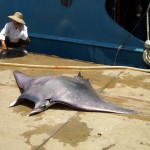Not that long ago, subsistence fishermen in Indonesia occasionally encountered and landed manta rays which they consumed for food. Often congregating near the surface in specific locations, mantas are easy targets for fishermen. But, lacking the good taste of other readily available fish and any significant economic value, manta landings were an infrequent occurrence.
In recent years two new markets have emerged in Asia which threaten this status quo.
The shark fin industry has received considerable attention for its questionable practices that supply the region’s luxury hotels and restaurants. Indonesia has been the leading harvester of sharks since the 1970s, and has accounted for around 15% of the worldwide catch since 1998. This means that Indonesian vessels officially catch around 122,000 tones of shark per year, but with widespread unregulated and unreported fishing in Indonesia, this figure is likely to be significantly higher. What may come as a surprise to many is that the shark fin industry is not picky. The fins of many diverse species make it into the shark fin pot, including manta ray wing tips.
Another factor leading to increased manta ray harvests is the new demand for brachial gill plates which are used in traditional Chinese medicine. Dried gill plates are used for such wide ranging remedies as cures for diabetes, the common cold, and cancer. Medical evidence to support these treatments remains questionable.
The demand has lead to an exponential increase in the Indonesian manta fishery over just a few years. Around the small Indonesian town of Lamakera, more than 1,500 mantas were harvested during a six-month period.
Indonesia’s manta ray fishery has changed. No longer a subsistence fishery using harpoons and non-motorised wooden boats, today fishermen employ commercial fishing techniques and motorboats. To date the fishery remains unregulated, with no concrete steps to assess its sustainability. Without regulation, the fishery risks posing a great threat to manta ray populations, and to the security of local livelihoods.
Tell us your opinions in the comment below. Is the growth of Indonesia’s manta ray fishery good news for local economies and development? Or could long-term environmental and social impacts overshadow short-term economic gains? What steps should be taken, and who should lead? Let us know your thoughts in the comments below.



